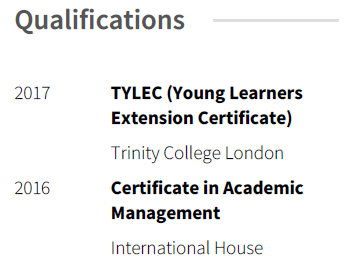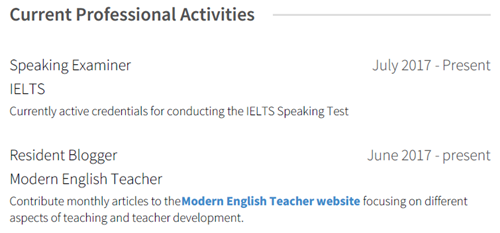6 Tips for a Top Teaching CV
In the second post in his series on career development, MET resident blogger David Dodgson offers some advice on expanding and putting together your CV ready to grab the attention of potential employers. Drawing on his own experience as a recruiter and an applicant, he discusses what to include, what to highlight, and how to present it. As always, your comments and tips are welcome in the comments.
So, you have the qualifications, you have built up a variety of teaching experience, and perhaps you have taken on non-teaching roles such as writing materials, preparing assessments, or giving INSETTs. How then, in a global industry like English language teaching, do you present all that to potential employers?
One key document to present all of the above is, of course, the CV (or resume if you prefer). Far from being a simple list of past jobs, qualifications, and specialist skills, this is a vital display of your professional talents and a chance to grab a recruiter’s attention (there are also the application form and covering letter, but I will address those in the next post).
 Speaking from the point of view of both someone who has applied for many roles over the years and as someone who has been involved in reviewing and shortlisting applications, this post will share six tips for putting a CV together, and I invite you to share your own advice in the comments section.
Speaking from the point of view of both someone who has applied for many roles over the years and as someone who has been involved in reviewing and shortlisting applications, this post will share six tips for putting a CV together, and I invite you to share your own advice in the comments section.
Tip #1 – Always keep it up to date
Speaking with my applicant’s hat on first of all, this is something I have learned the hard way. Early in my career, I would put a CV together on a needs basis. When a job opportunity came up, that is when I would sit down and start putting my CV together. This seemed logical at the time – a CV was part of applying for a job so why worry about it when not seeking a new role?
However, as my experience grew, my CV became an increasingly difficult document to manage. Reworking it and editing it, especially after several years working in the same institution, became a stressful task. With application deadlines looming, I would be scratching my head trying to remember exact dates of courses and seminars and wondering where to fit in that six-week course preparing my students for the school debate.
Now, I revise and review my CV on a regular basis and there are two reasons I do this:
a) As mentioned above, it means I can capture activities like training sessions I have given, projects I have been involved in, and different contexts I have worked in at or close to the time they take place, allowing me to capture the key details.
b) My CV is always ready (or nearly ready) to be sent off to potential employers. You never know when a work opportunity, full-time or short-term, will come up and having your CV ready to go after a few key edits (more on those below) will save time and stress.


Tip #2 – Give prominence to experience and qualifications
Speaking now with my recruiter’s hat on, always give prominence to your work history and qualifications. There are times when an advertised role may receive great interest but with a shortlist of only five or six to be drawn up for interviews, a ruthless elimination process takes place.
One of the first places to look is experience and qualifications – do they match the job requirements as specified in the ad? Being able to immediately spot an easy-to-read list of jobs done, years of experience accumulated, and qualifications earned (along with dates and institutions), will increase the chances of potential employers adding you to that long/short list pile (assuming you meet the requirements of course, but more on that in the next post).
I would suggest the following presentation:
a) Give prominence to the job title, school/institution and location, and dates of employment along with details of whether the role was full-time, part-time, freelance or another arrangement.
b) Put the above in bold on one or two lines with regular font bullet points to give details about your responsibilities below.
c) List any other professional activities you are involved in (e.g. occasional examiner work, tutoring, or training) in a separate section so your key work roles remain prominent.
d) Put qualifications in a separate list highlighting the title, awarding body/institution, and date of award (or expected completion date if the course in on-going).
e) Put your work history, qualifications, and other activities in reverse chronological order so the most recent points are shown first.
Layout and formatting is also important here (see also Tip #5) as are the details you give for each role – read on for those.

Tip #3 – Emphasise relevant aims and achievements
My CV begins with my personal contact details (phone number and email being key but also include a link to your professional blog, website, and/or LinkedIn page if you have them) and my aim in seeking new employment. I will focus on what this aim should be in more detail in the next post, but for now I will emphasise that it should be tailored to the job you are applying for (one of the key edits mentioned earlier).
Then I will highlight the career history and qualifications as outlined above. Below the headings, we need the details. The best advice I can give here from both the applicant and recruiter side is to be specific and succinct.

Generic ‘taught x to y’ descriptions of your work will not help you stand out, nor will a detailed paragraph describing your role and responsibilities. Believe me, when there are tens of applications to sort through, even a six-line paragraph is unlikely to be read in detail.
Use bullet points to summarise the main aspects of your role in 1-2 lines with an emphasis on what was achieved. Instead of the generic ‘Taught general English and exam preparation to young learners’ we can try something like this:
- Developed literacy skills in 6-7 year-old beginners through a story-based learning programme enabling them to progress to elementary level.
- Prepared primary learners for the Starters exam using adapted and self-made materials with all students achieving three shields or above across all assessed skills.
Now, in place of a standard unremarkable line, we have a much clearer idea of the work done. We know the specific age range and level, how the progress was achieved, and the outcome. If these points are also relevant to the role you are applying for, we have a winning formula!
Also important to include here are any extra tasks and projects you have been involved in (see my previous post for a discussion on these) as these will show your commitment to your job beyond the classroom.
There is no need to do this for every job you have had (unless you have only had one or two to date!) Include more details about your most recent positions – no need to break down everything to this extent for a job you had 15 years ago.

Tip #4 - Show your wider professional contributions
Work history and qualifications are the first places most employers will look. However, they will then look at the extra details, which may be crucial in deciding between one person or the other. This is the place to include details of volunteer work, INSETT or conference sessions you have given, articles or blog posts you have written, membership of professional associations, and any other relevant activities.
These are important to show your involvement in the ELT profession beyond your classroom teaching. Of particular interest will be any training sessions you have delivered (much more so than those you have simply attended), whether internally or at conferences, as they will highlight the contributions you could potentially make to other schools or institutions.
Also of interest may be other work, paid or voluntary, you have taken on beyond your full-time roles. For example, in recent times I have worked as an IELTS examiner, Distance DELTA Local Tutor, IATEFL YLTSIG Committee Member, and of course MET Resident Blogger. Including these in their own section allows me to highlight my wider work while not burying my recent full-time positions.
As your experience and professional engagement grows, you may find you have a long list of talks, articles, and more. There is no need to list them all – having a section of selected publications, training, or other work experience will allow you to highlight the most relevant roles and emphasise that there is depth to your experience.
I personally would also avoid the classic ‘skills and interests’ section. Space on a CV is at a premium and if you have more than a few years’ experience, describing your passion for fly-fishing or your starring role in middle school drama club potentially takes away from your professional skills. Only include wider interests if they are current and relevant, for example something you could offer as an extra-curricular activity.
Tip #5 – Think about language, layout and length
In Tip #3, we discussed how to describe and highlight your work experience succinctly, and it is a good idea to maintain concise language across all sections of your CV. Bullet points and clear but detailed headings are key here.
The majority of qualifications are well-known in our field and do not need descriptions. Any particular details of research you did, special awards and grades can be saved for other parts of your application (in the next post!)
Emphasise headings by using a larger font size and putting them in bold. Consider bold also for key words in your descriptions. Provide evidence by adding hyperlinks to any online record of your achievements. You might want to link to that class blogging project for example or a recording of that webinar you did and the article you wrote to go with it.
It goes without saying of course that your choice of font should be professional and easy to read. A sans serif font will display better on a screen (the odds of your CV being printed out are almost zero) and it is common sense to avoid Comic Sans and Chiller.
Also, consider using columns. For a long time, I was never sure whether to display my work history or qualifications first, especially as the lists got longer. The solution was to use a wide column to display my work experience with a narrow column to the side detailing my qualifications, projects, and articles. That allows me to condense over 15 years of ELT experience into two easy to read pages without missing key components out.

Tip #6 – Proof-read and get a second opinion
Identifying and correcting typos and spelling mistakes is extremely important to avoid creating a negative impression, especially considering that we work in English language teaching.
Spellcheckers and our own eyes often do not pick up everything. Some people find it useful to review a printed version so consider doing that. Also, enlist help from a colleague or friend with a good eye for small errors and get them to review it.
As well as checking for errors, seek out feedback on the content. Teaching colleagues may remind you of aspects of your work you have omitted or have other useful suggestions. Asking someone who is not a language teacher is also useful to make sure what you have written makes sense.
Those are my top six tips for a language teacher’s CV. Do you have any to add? Or are there any you disagree with? Please let us know in the comments section!
Next time, we will look at the wider process of applying for jobs with applications and cover letters.
Part 1: From TEFL Job to TEFL Career
Comments
Write a Comment
Comment Submitted